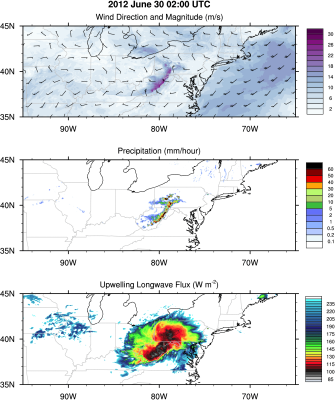The June 2012 North American Derecho: A Testbed for Regional and Cloud-System Resolving Models
The June 2012 North American Derecho delivered extreme winds and heavy precipitation to much of the U.S. Northeast and left devastation in its wake. This study demonstrates the feasibility of simulating the 2012 North American Derecho in the regionally-refined Simple Cloud Resolving E3SM Model (SCREAM) and proposes a testbed based on this historically impactful event. The June 2012 North American Derecho delivered extreme winds and heavy precipitation to much of the U.S. Northeast and left devastation in its wake. This study demonstrates the feasibility of simulating the 2012 North American Derecho in the regionally-refined Simple Cloud Resolving E3SM Model (SCREAM) and proposes a testbed based on this historically impactful event.
E3SM/SCREAM has immense potential for simulating historic extreme weather events and their future analogs. This study successfully demonstrated how it can be used for studying similar local-to-regional-scale high-impact extremes.
A set of metrics and diagnostics based on the observed 2012 North American Derecho has been developed for intercomparing model simulations. This historically impactful storm was simulated in SCREAM at 1.6km, 3.25km, and 7.5km grid spacing over its historical path and in the Weather Research and Forecasting (WRF) model at 3.25km. Results showed that SCREAM is comparable in performance to WRF for this event, despite being a global climate model. Simulation results are particularly sensitive to the initial conditions (ICs), initialization time, and model configurations, with ICs from the Rapid Refresh producing the best simulation. Significant improvement is identified in both models as horizontal grid spacing is refined. While a propagation delay of approximately 2 hr is found in both models, SCREAM at 1.625 km simulates the observed bow echo structure of the derecho well and predicts strong surface gusts that exceed 30 m/s. In comparison, WRF has difficulty producing surface wind over 25 m/s, with wind gusts in WRF 42%–46% lower than in SCREAM. However, WRF has a lower bias in simulating cloud top temperature and extent but overestimates precipitation intensity.

